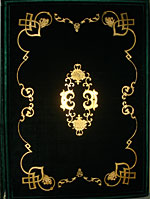Appearance of Manuscripts
Despite an abundance of presentation music manuscripts in the collection of the National Library of Russia, there is very few authors' autographs, written in their own hands. The most portion of the tributes were accurately reproduced by proffesional copyists, and this is quite understandable. It was not accepted to present a composer's manuscript, not neatly written, to royal persons. During the 18th century and in the first half of the 19th century, autographs of contemporaries were held in low regard. To make manuscripts look more attractive, musicians commissioned them to a professional copyist and binder. And this rule is respected by not only Russian composers. The Italians and the Frenches rarely took such liberties - to give manuscripts written in their his own hands to Russian Emperors.
Professional copyists prepared a presentation copy of the composer's score. After copying, an author's autograph often get lost, in a case like that the copy remains the only source for the score.
As mantioned before, presenting music manuscripts to the members of the Imperial family, the authors were hoping for royal approval and expected their works to be published and performed. To produce an impression, musicians tried to make the gift more attractive, finely decorating it. The manuscripts were bound in morocco or velvet embossed in gold, their gilt-edged leaves were beautifully calligraphed and embellished with colourful ornaments.But along with luxury gifs, there are simple and modest musical notebooks without bindings. The front page of one of these notebooks reads, 'To His Majesty the Emperor Alexander Nikolaevich, three choirs simultaneously sing the following three prayer pieces about the welfare of the Tsar: «God Save the Tsar, Long Life, and Christ our God Save». A humbly offering from the state peasant Sergei Alexandrov.'
